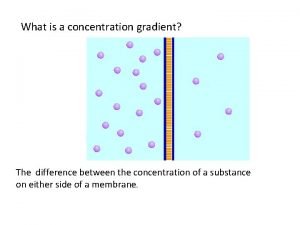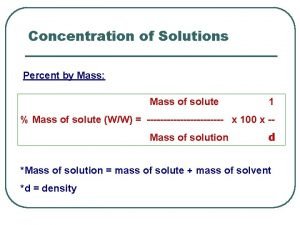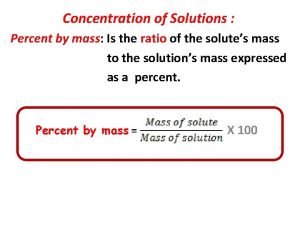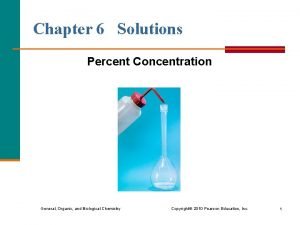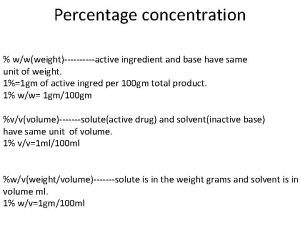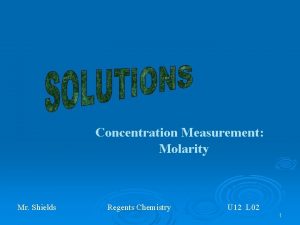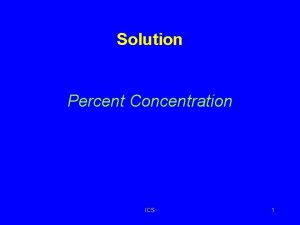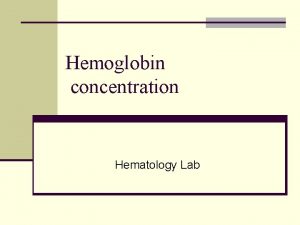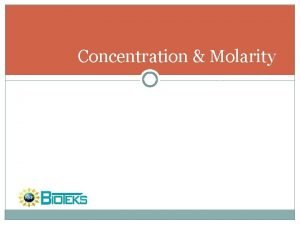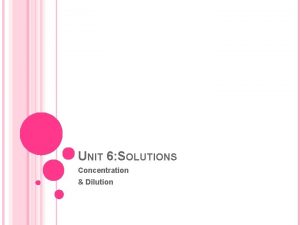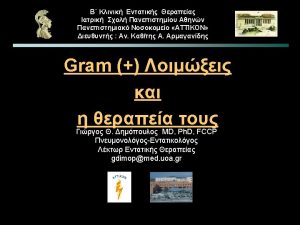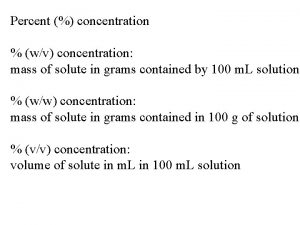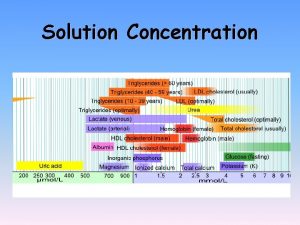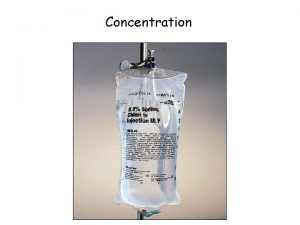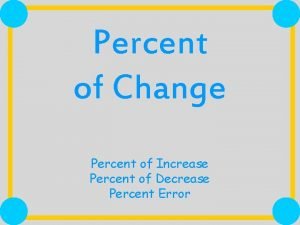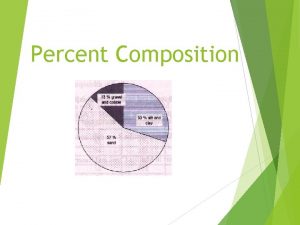Concentration Measurement Percent and PPM Mr Shields Regents















- Slides: 15

Concentration Measurement: Percent and PPM Mr. Shields Regents Chemistry U 12 L 03 1

Percent Concentration (V/V) The two “Percent” methods for measuring Concentration are Volume/Volume (V/V) and Mass/Mass (m/m). Let’s look at the V/V method 1 st: The formula for % Concentration (V/V) is: Percent (V/V) = Volume of solute x 100 Volume of Solution 2

Percent Concentration (V/V) Using Percent (V/V) to specify Concentration is used when BOTH the solute and solvent are liquids Example: water + vinegar (H 20 + CH 3 COOH) It also assumes no INTERACTION (i. e. reaction) between The solute and the solvent. And notice that we are dividing the volume of the SOLUTE By the volume of the SOLUTION – not the other way around Percent (V/V) = Volume of Solute x 100 Volume of Solution 3

Percent Concentration (V/V) V/V solution concentrations tells us what % of solute is present in the solution. Doubling the amount of solute will Not necessarily double the % V/V. As we add solute to the solvent the volume of the solvent also increases. % V/V = 3/9 = 33% % V/V = 6/12 = 50% How much solute and solvent is present in each? AND REMEMBER ! It is essential to express both the Solute and the solution volumes in the SAME UNITS. For example Liters and Liters or Milliliters and Milliliters, 4

Percent (V/V) Problem 27 ml of ethanol are dissolved in 270 ml of Octane. What is the % Concentration of Ethanol? % Conc. (V/V) = 27 ml x 100 (27 + 270) = 9. 1% What is the concentration in % (V/V) if 1. 5 ml of Vinegar Is dissolved in 30 ml of water? % conc. of vinegar (V/V) = 1. 5 ml x 100 (1. 5 + 30) = 4. 76 % Note: Vinegar bought at the store is about a 5% sol’n 5

Percent Concentration (m/m) Percent Concentration by mass, % (m/m), is calculated very Much like the % (v/v) method: Percent (m/m) = Mass of solute x 100 Mass of Solution NOTE it’s the mass of the Solution and NOT the just the Solvent. As in v/v calculations the total solution is equal to the sum of Both the Solute and the Solvent mass + mass = mass 6

Percent (m/m) Problem 1) What is the % Concentration (m/m) of I 2 if 16. 7 g of I 2 Are dissolved in 250 g of ethanol? % Conc. (m/m) = 16. 7 g (16. 7 g + 250 g) x 100 = 6. 26% 2) 24 g of Ag. NO 3 were dissolved in 125 ml of water. What Is the % concentration (m/m) of Ag. NO 3 in solution? Desity of H 2 O = 1 g/ml; the mass of the water = 125 g Conc. of Ag. NO 3 (m/m) = 24 g x 100 (24 + 125) = 16. 1% 7

PPM The last method of expressing sol’n concentrations Quantitatively is PARTS PER MILLION (i. e. ppm) This method is used extensively in the Environmental Field. Why is the case? It’s a method that allows one to easily comprehend the Concentration of extremely small amounts of solute in Solvent. So we might find for example that a sample of drinking Water contains 3. 2 ppm of Arsenic and compare that to the allowable levels of As in drinking water (0. 05 ppm) 8

PPM If the allowable limits of As in drinking water is 0. 05 ppm, What does this mean in terms of concentration? - First, 1 ppm means 1 part in 1 million (106) parts So, if the acceptable level of As is 0. 05 ppm then for every 5 Molecules of As molecules allowed in drinking water there must be 100, 000 (108) molecules of water. Expressed another way we could say… - for every 5 g of As there must be 100, 000 g of H 20! 9

PPM Calculations How do we calculate ppm? We’ll use this equation… ppm of solute = Mass of Solute x 106 Mass of Solution Notice that again we are dealing with the TOTAL mass Of the solution. Let’s look at an example… 10

PPM Calculations A 6. 5 g sample of well water is found to contain 3. 5 x 10 -6 g of Pb+2. What is the concentration of lead In the well water in ppm? PPM Lead = mass of the solute x mass of the solution 106 PPM Lead = 3. 5 x 10 -6 g x 106 6. 5 g Is this the total mass? PPM Lead = 0. 538 ppm Why can we use it? 11

PPM Calculations What is the concentration in ppm of Na. Cl in water if 1. 2 g is dissolved in 240 ml of water? PPM Na. Cl = mass of the solute x mass of the solution PPM Na. Cl = 106 1. 2 g x 106 = 4975. 1 ppm (1. 2 +240)g The salinity of sea water is about 35, 000 ppm 12

PPM Calculations What if we hadn’t added in the 1. 2 g of Na. Cl to the Mass of solvent (240 g). Would it have made a difference? Let’s check it out … PPM Na. Cl = mass of the solute x mass of the solution PPM Na. Cl = 106 1. 2 g x 106 = 5000 ppm 240 g Mass of solvent ONLY YES! It would have made a difference 5000 ppm vs 4975 ppm So always add in the mass of the Solute to the solvent if it is a Significant amount 13

PPM Calculations What if we had only added in 1. 2 mg of Na. Cl to 240 ml Of water. Does it make much difference if we add the Mass of the salt to the solvent? Calculate it both ways and see … PPM Na. Cl = 0. 0012 g (0. 0012 + 240)g PPM Na. Cl = 0. 0012 g 240 g x 106 = 4. 999975 ppm x 106 = 5. 000000 ppm Are these two numbers significantly different? No, not really! So here we could have ignored the mass Of the salt 14

Global Warming is blamed on the increase in CO 2 Levels in the atmosphere. A) How much did CO 2 increase in both ppm and % between 1957 and 2000? B) In 2000 what Was the Percent by Volume of CO 2 In the atmosphere? 54 ppm increase or 16. 98% increase in CO 2 (372 -318)/318 x 100 372 X 100 = 106 O. 037% 15
 Concentration gradient
Concentration gradient Movement of high concentration to low concentration
Movement of high concentration to low concentration Valid percent چیست
Valid percent چیست How to convert percent to molarity
How to convert percent to molarity How to find percent concentration
How to find percent concentration How to calculate mass concentration
How to calculate mass concentration Chemistry mass percent
Chemistry mass percent Percentage concentration
Percentage concentration St wilfrid's rc college south shields
St wilfrid's rc college south shields Shield middle school bus ramp
Shield middle school bus ramp Knights shields designs
Knights shields designs Linda evangelista face shape
Linda evangelista face shape It traps heat shields the surface from harmful radiation
It traps heat shields the surface from harmful radiation What types of lifeboat are there
What types of lifeboat are there Busrampwixsite
Busrampwixsite Art shields
Art shields
